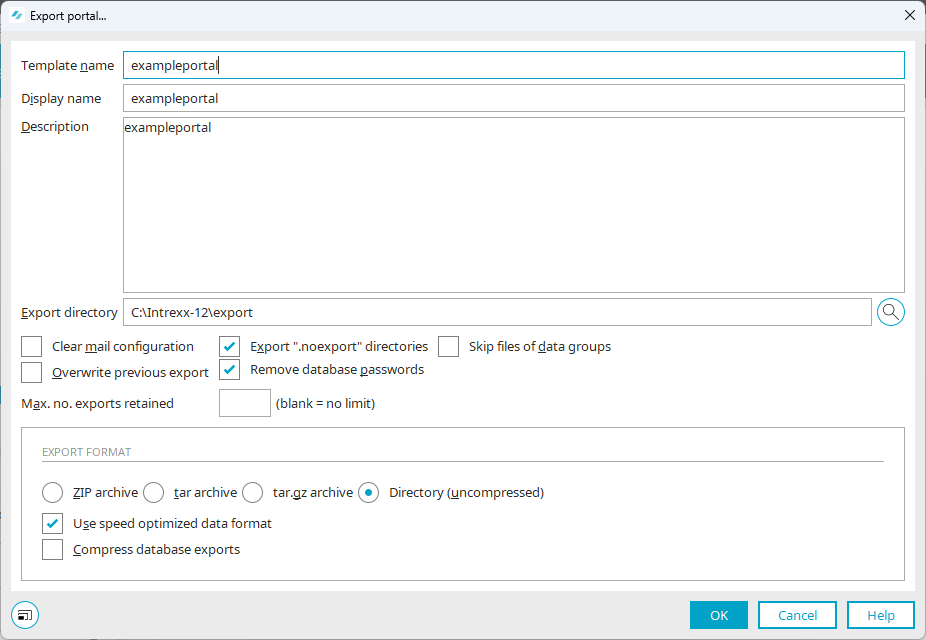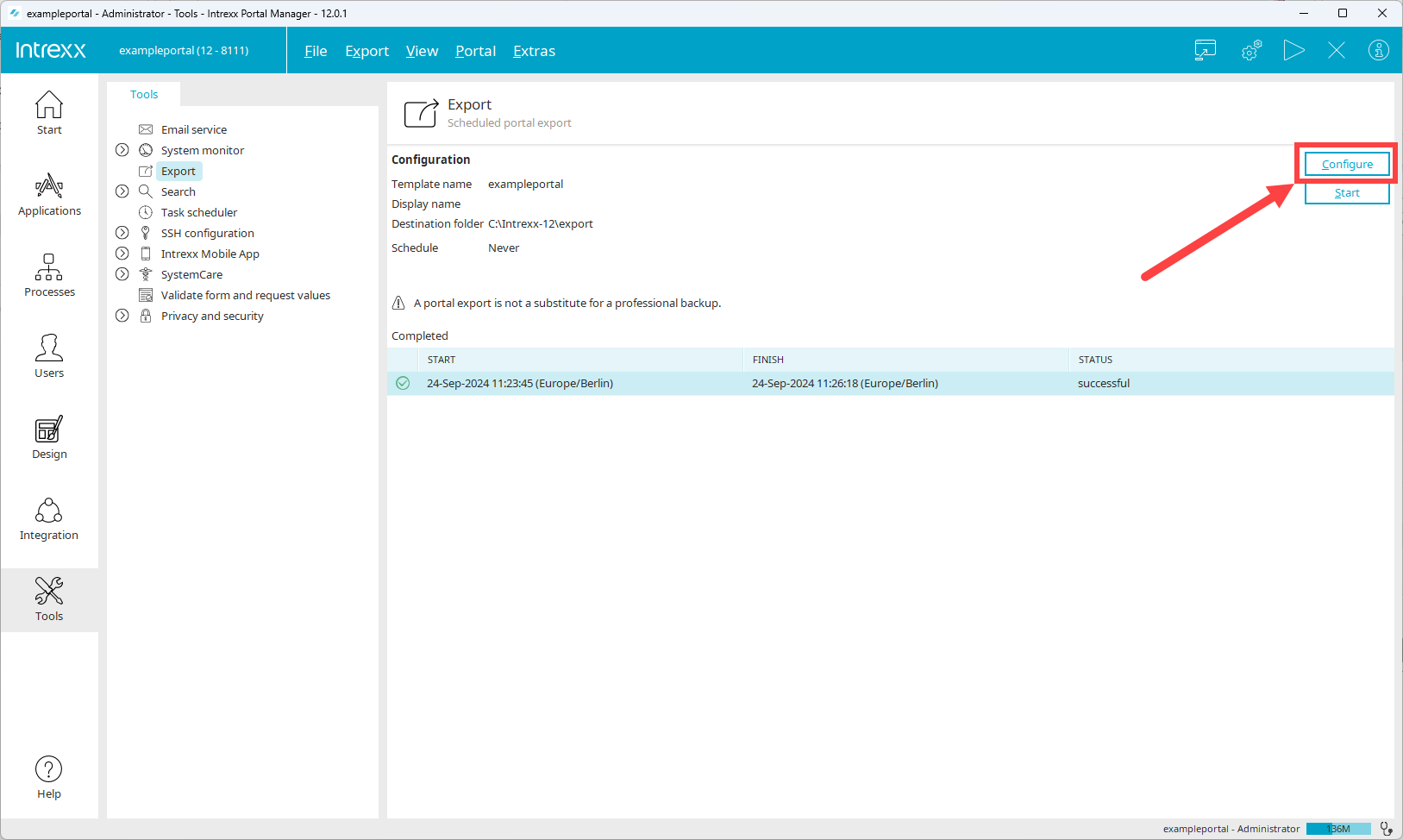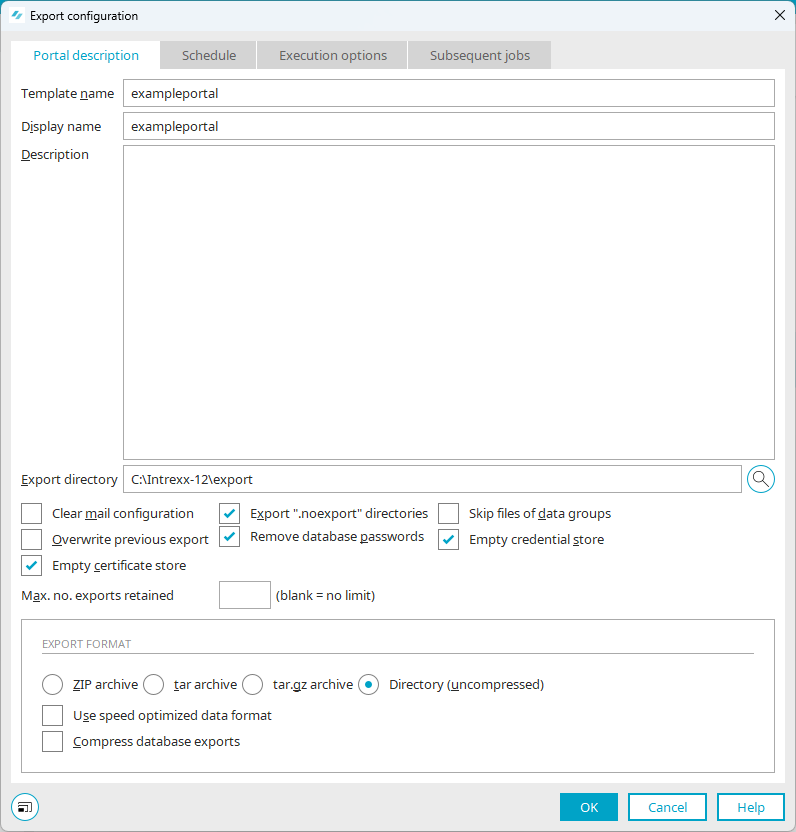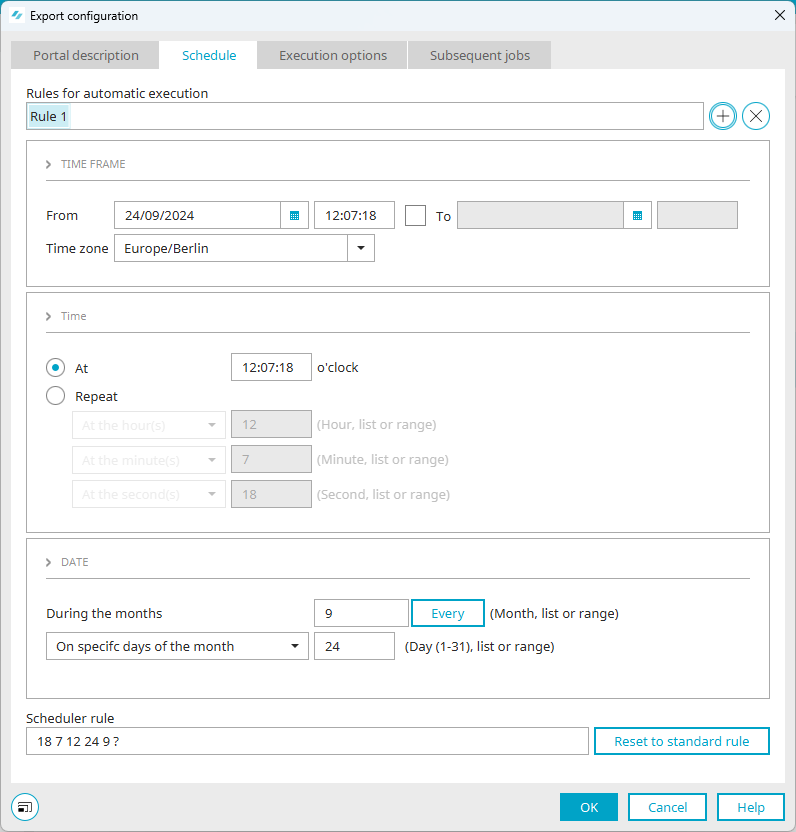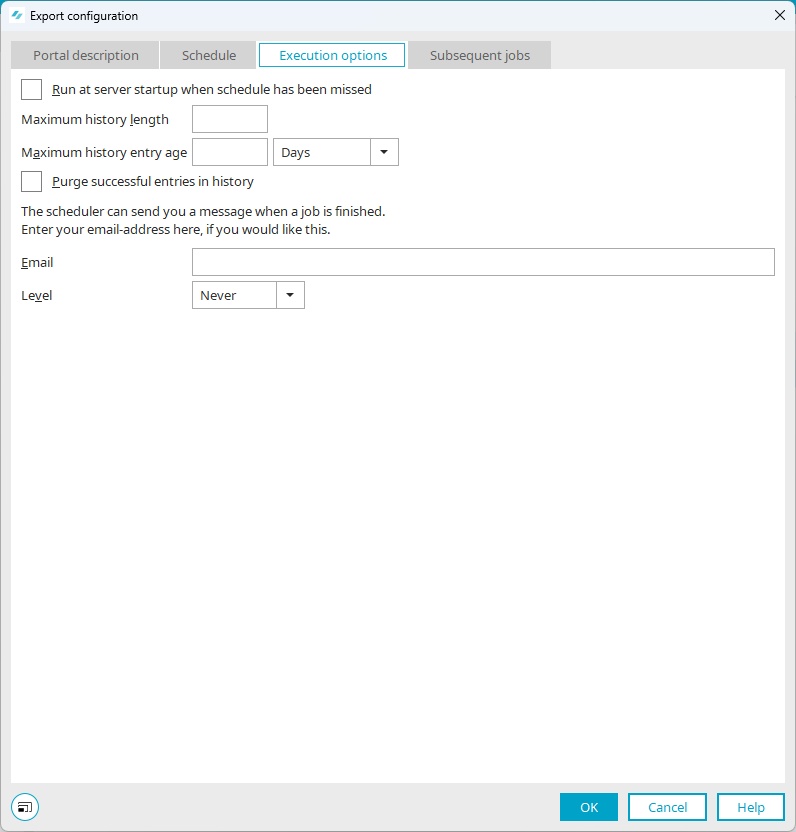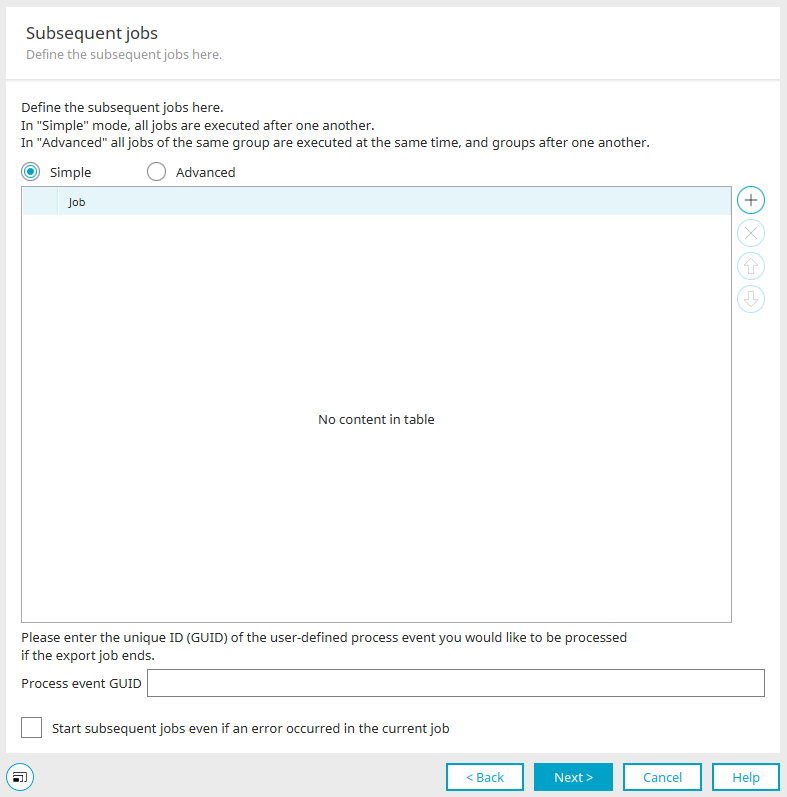Export portal
You can export portals manually via the Start module or automatically via the Tools module.
When exporting automatically, you can configure a number of additional options. This includes, among other things, setting the export time or an export cycle if you want to run an export on a regular basis. In addition, you can automatically trigger further follow-up orders during automatic export.
Manually export portal
Step-by-step guide
To export a portal manually, proceed as follows:
-
Launch the portal you want to export.
-
Click on "Start > Export Portal..."
The "Export portal..." dialog box is displayed.
From Intrexx version 12.0.0
Template name
Template name This corresponds to the filename used for the export file.
Display name
When the portal is being imported, the display name is used in the template list (local).
Description
You can provide the portal export with a description here.
Export directory
The path where the export file will be saved is shown here.
 Select folder
Select folderOpens a dialog where a directory can be selected.
Clear mail configuration
With this setting, the settings that are defined for the current portal in the "Tools" module under Email Service are not included in the export.
Overwrite previous export
With this setting, the last export will be overwritten by the new one.
Clear certificate store
With this setting, no certificates are included in the export. Click here for more information about this topic.
Export ".noexport" directories
You can exclude directories from the export by placing a ".noexport" file in the corresponding directories.
If you do not want to exclude directories that contain a .noexport file from the export in certain scenarios, you can do so by activating this checkbox.File ".noexport"
By default, temporary directories in Intrexx contain .noexport files, as these are not required for the portal export or the exported portal.
If you exclude directories from export yourself with the help of .noexport files, you should document this.
You can create a .noexport file yourself using an editor.
You can find a sample file that you can copy in the following directory: <intrexx-installation-directory> \orgtempl\blank\internal\tmp
File ".keep"
In addition to the ".noexport" file, you can also create a ".keep" file in connection with the portal export. If you save a .keep file in an empty directory, this will also be exported during the portal export. (Empty directories are not exported by default)
You can find a sample file that you can copy in the following directory: <intrexx-installation-directory> \orgtempl\blank\internal\tmp
Remove database passwords
With this setting, the passwords for authentication to the portal database will be reset in the portal export. Logging on to the database will then be possible without a password.
Number of exports to be retained
Here you can specify how many portal exports should be retained in total. If this number is exceeded, the oldest export will automatically be deleted.
Skip files from data groups
With this setting, files from data groups are not included in the export.
(Detailed information on files in file fields or data groups can be found in section Data fields
From Intrexx version 12.0.0: Empty login information memory
With this setting, no credential passwords are included in the portal export. Further information on credentials can be found here.
Export format
Four export formats are available:
-
ZIP archive
-
tar archive
-
tar.gz archive
-
Directory (uncompressed)
Use speed optimized data format
With this setting, the XML in the export file is written in a format that can be read faster during the import.
Compress database exports
With this setting, the database export files (.data) are compressed as a gz file (.data.gz). In this way, the database export files require less space in the export directory.
-
<intrexx-installationdirectory>\org\<portalname>\internal\cfg\.
If necessary, you can make changes to the file manually.
Note that when exporting a portal, the portal.wcf file is exported as well, but when importing it afterwards, it is imported without any manual changes; I.e. you have to maintain the portal.wcf file manually if necessary.
Background The portal.wcf file contains system-specific information, such as paths or ports, which normally cannot be transferred 1:1 from one system to another.
Automatically export portal
Step-by-step guide
To export a portal automatically, proceed as follows:
-
Start the "Tools" module.
-
Click on "Export" in the navigation area.
-
Click on "Configure".
The "Export configuration" dialog appears.
Portal description
Template name
Template name This corresponds to the filename used for the export file.
Display name
When the portal is being imported, the display name is used in the template list (local).
Description
You can provide the portal export with a description here.
Export directory
The path where the export file will be saved is shown here.
 Select folder
Select folderOpens a dialog where a directory can be selected.
Clear mail configuration
With this setting, the settings that are defined for the current portal in the "Tools" module under Email Service are not included in the export.
Overwrite previous export
With this setting, the last export will be overwritten by the new one.
Clear certificate store
With this setting, no certificates are included in the export. Click here for more information about this topic.
Export ".noexport" directories
You can exclude directories from the export by placing a ".noexport" file in the corresponding directories.
If you do not want to exclude directories that contain a .noexport file from the export in certain scenarios, you can do so by activating this checkbox.File ".noexport"
By default, temporary directories in Intrexx contain .noexport files, as these are not required for the portal export or the exported portal.
If you exclude directories from export yourself with the help of .noexport files, you should document this.
You can create a .noexport file yourself using an editor.
You can find a sample file that you can copy in the following directory: <intrexx-installation-directory> \orgtempl\blank\internal\tmp
File ".keep"
In addition to the ".noexport" file, you can also create a ".keep" file in connection with the portal export. If you save a .keep file in an empty directory, this will also be exported during the portal export. (Empty directories are not exported by default)
You can find a sample file that you can copy in the following directory: <intrexx-installation-directory> \orgtempl\blank\internal\tmp
Remove database passwords
With this setting, the passwords for authentication to the portal database will be reset in the portal export. Logging on to the database will then be possible without a password.
Number of exports to be retained
Here you can specify how many portal exports should be retained in total. If this number is exceeded, the oldest export will automatically be deleted.
Skip files from data groups
With this setting, files from data groups are not included in the export.
(Detailed information on files in file fields or data groups can be found in section Data fields
From Intrexx version 12.0.0: Empty login information memory
With this setting, no credential passwords are included in the portal export. Further information on credentials can be found here.
Export format
Four export formats are available:
-
ZIP archive
-
tar archive
-
tar.gz archive
-
Directory (uncompressed)
Use speed optimized data format
With this setting, the XML in the export file is written in a format that can be read faster during the import.
Compress database exports
With this setting, the database export files (.data) are compressed as a gz file (.data.gz). In this way, the database export files require less space in the export directory.
-
-
Go to the "Schedule" tab.
Schedule
Define the how often the task should be automatically executed.
Rules for automatic execution
Any number of rules with differing schedules can be created here. Created rules can be selected and activated individually meaning the task is executed with the corresponding schedule. Create a rule, modify the settings (such as the time) in the dialog as needed and save the rule either by switching to another rule or by closing the dialog with "OK".
 Add rule
Add rule Adds a new rule.
 Delete rule
Delete rule Deletes the rule currently selected.
Time frame
From
Defines the start of the period. The task will be executed for the first time at the beginning of the next hour after the value entered in the "From" field.
To
Defines the end of the period.
Time zone
Defines the time zone.
Time
At
With this option, a specific time can be entered when the task should be executed.
Redo
With the settings "At the hour(s) / minute(s) / second(s)" you can enter an integer for a single hour (or minute/second), a list (separated by a comma) or a period (e.g. 8-10).
By clicking on the
 arrow button to the right of these settings, you can select the option "Every". This allows you to define an interval in hours, minutes and seconds relative to the last execution.
arrow button to the right of these settings, you can select the option "Every". This allows you to define an interval in hours, minutes and seconds relative to the last execution. Date
During the month(s)
Here, you can enter an integer for a single month, a list (separated by a comma) or a period (e.g. 3-5) to determine in which month(s) the task should be executed. Click on "All" if you want to execute the task throughout the year.
On specific days of the month
Corresponds to the setting "During the month(s)" but for the days.
Click on the
 arrow button to the right of this setting to select other options from the submenu.
arrow button to the right of this setting to select other options from the submenu. Repeat every
Enter the desired number of days before the end of the month.
On specific days of the week
Define the desired days of the week.
Days before the end of the month
Enter the desired number of days before the end of the month.
Scheduler rule
The scheduler rule can be entered manually here. Information about the construction of these rules can be found here. A detailed description of CronTrigger expressions can be found here (CronTrigger class).
Reset to default rule
If you click on this button, Intrexx will check the scheduler rule. If Intrexx detects errors, a rule is automatically built, which can be implemented via the input fields in this dialog box. Invalid values in the scheduler rule are discarded.
-
Go to the "Execution Options" tab.
Execution options
Run at server startup when schedule has been missed
With this setting, task will be executed that have not been carried out while the server was stopped.
Maximum history length
The number of entries is limited to the integer entered here.
Maximum history entry age
Defines how long the history entries are valid in milliseconds, seconds, minutes, hours or days. The entries in the history are only corrected when a new run takes place.
Purge successful entries in history
If you activate this check box, only the last successfully completed job will be displayed in the history.
Email
An email address can be entered that a message will be sent to as soon as the status, which is selected below, applies.
As of Status
You can select the following values:
- Never
A message will not be sent.
- Errors
A message will be sent if errors occur during execution.
- Warning:
A message will be sent when warnings are encountered.
- Always
A message will always be sent.
- Never
-
Go to the "Subsequent jobs" tab.
Subsequent jobs
You can arrange for Intrexx to automatically execute other subsequent jobs after the portal export. Subsequent jobs can also be defined in the "Tools" module in the Task Scheduler when configuring tasks and in the "Integration" module when configuring data transfers.
Click on the
 icon to add a new subsequent job.
icon to add a new subsequent job.You can arrange for subsequent jobs to be executed in "Simple" and "Advanced" mode.
Simple
After the actual job, all subsequent jobs are executed one after the other.
Advanced
Using this option, subsequent jobs can be organized into groups. Jobs from the same group are performed at the same time after the actual job. The groups are performed one after the other.
Process Event GUID
A process can be performed once the subsequent jobs have been performed successfully. Enter the GUID of the process here.
Start subsequent jobs even if error occurred in the current job
If you select this check box, all jobs will be executed, even if one of the jobs was canceled due to an error.
-
Click on "OK" to complete the configuration.
<intrexx-installationdirectory>\org\<portalname>\internal\cfg\.
If necessary, you can make changes to the file manually.
Note that when exporting a portal, the portal.wcf file is exported as well, but when importing it afterwards, it is imported without any manual changes; I.e. you have to maintain the portal.wcf file manually if necessary.
Background The portal.wcf file contains system-specific information, such as paths or ports, which normally cannot be transferred 1:1 from one system to another.
Exclude database tables from export
The instructions described below are aimed at Intrexx administrators.
In the course of a portal export, you have the option of excluding database tables from the export. To do this, you must enter the names of the tables in the configuration file exportexcludetables-custom.cfg under <intrexx-installation-directory>\org\<portalname>\internal\cfg\.
You must create the configuration file exportexcludetables-custom.cfg.
The configuration file contains one regular expression per line that matches excluded tables. Lines beginning with # are treated as comments. A whitespace at the beginning and end of a line is ignored. Empty lines and lines consisting only of whitespaces are ignored.
Sections that begin with [schema+data] , [data] or [schema] can be defined in the file. Regular expressions in these sections then prevent the export of matched tables for schema and data or only of the data or only of the schema. The default is schema and data.
Example 1
# All tables starting with "CRITICAL_TABLE_"
CRITICAL_TABLE_.*Example 2
# Completely ignored tables
[schema+data]
CRITICAL_TABLE
# Export without data
[data]
HUGE_TABLE
GDPR_.*.More information
https://help.intrexx.com/apidocs/jdk21/api/java.base/java/util/regex/Pattern.html
Anonymize exported portals
You have the option of anonymizing exported portals. In this case, the data in the portal is replaced by meaningless information. This allows you to send portals to Intrexx Support, for example, without passing on personal or critical data.
Anonymizer
The anonymization of exported portals is carried out by what is known as the "anonymizer". This is an integral part of Intrexx and does not have a graphical user interface.
The anonymizer performs the following steps to anonymize the portal:
-
Replaces words that have three or more letters with random words of the same length, whereby within the portal a word is always replaced by the same random word. This replacement also extends to constants and static titles.
-
Replaces numbers with random numbers of the same length, whereby within a portal a number is always replaced with the same random number.
-
Replaces images and other files with empty dummy files. The files are randomly renamed to make it impossible to make inferences about the content.
-
Replaces user names with random user names, removes passwords.
-
Removes the history of applications and processes by deleting the associated git repositories.
-
Removes temporary files, mails, uploads, etc.
Executing the anonymizer
The anonymizer is executed via a script.
Windows anonymizeportal.bat
Linux/Mac anonymizeportal.sh/
The script can be found in the following directory: <intrexx-installation-directory>/bin
The anonymizer requires a portal export as a directory, zip or tar. A portal that is actively operating cannot be anonymized.
The anonymizer can be started using anonymizeportal.sh or anonymizeportal.bat from the bin directory. During anonymization, a log of the steps taken is created and stored under log/anonymizeportal.log.
Options
The anonymizer offers the following options:
anonymizeportal.sh <Source> <Target> [Options]
The portal to be anonymized (as a directory or zip archive) and a target directory/name of the zip archive to be created must be specified as the <source> and <target>.
The anonymizer offers the following optional parameters:
--config=<xml-File> allows you to use an xml file to configure the anonymizer.
--workDir=<Directory> defines the working directory to which the portal is copied beforehand. If this parameter is not specified, the temporary directory of the operating system is used by default.
--replaceFiles=<Directory> A directory with images and other files to be used for the replacement can be specified here. If this parameter is not specified, (empty) standard images and documents are used to replace files in the portal.
--zip causes the anonymized portal to be compressed as a zip archive. If a zip archive is specified as the <Target>, this flag must be specified.
--logLevel=<Value> defines in how much detail the work steps are logged. INFO (default) and DEBUG are possible. If this parameter is not set, the standard Intrexx log level is used so that only warnings and errors are output in addition to the work steps. If DEBUG is specified, the process is described in detail. For example, filenames can also be displayed in the log before renaming.
Due to the relatively long file operations for extracting and compressing, it is recommended, especially under Windows, to anonymize a portal as a directory and only then, if necessary, to create a zip afterwards.
Caution After anonymization, the portal should always be imported into a test system and checked again to ensure that all content has been sufficiently anonymized.
Please also note that an anonymized portal may not always work in all areas due to the complex replacements. In such a case, the anonymized portal can only be used on test systems for troubleshooting.
